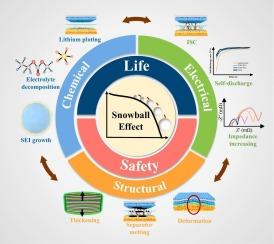The snowball effect in electrochemical degradation and safety evolution of lithium-ion batteries during long-term cycling
IF 10.1
1区 工程技术
Q1 ENERGY & FUELS
引用次数: 0
Abstract
Lifespan and safety are the most critical issues for the application of lithium-ion batteries (LIBs). During long-term service, the degradation mechanisms and safety evolution of LIBs remain unclear, posing significant obstacles to battery design and management. This study analyzes the electrochemical degradation mechanisms of LIBs under normal temperature cycling (NTC) and high-temperature cycling (HTC) conditions, linking these mechanisms to the evolution of battery safety. The findings reveal that during NTC, there is a “snowball effect” in performance degradation and safety evolution, leading to sudden death of battery and posing serious safety risks. The degradation pattern of LIBs during NTC and HTC is consistently dominated by the increase of internal resistance and the loss of lithium inventory (LLI). In the aging process, electrolyte consumption and the growth of the solid electrolyte interface (SEI) cause localized lithium plating on the anode, resulting in accelerated capacity decay. However, in batteries subjected to NTC, rapid accumulation of localized lithium plating can trigger a snowball effect, causing electrode deformation, internal short-circuit (ISC) and separator melting. These interacting catastrophic events form a vicious cycle, ultimately leading to battery sudden death and pose significant safety hazards. Additionally, thermal safety analysis reveals the correlation between thermal safety parameters and state of health (SOH), quantifying the thermal safety degradation caused by sudden death. Sudden death directly alters the evolution pattern of battery safety, leading to a severe decline in battery safety. These findings offer new insights into potential safety hazards associated with long-term use of LIBs.

锂离子电池在长期循环过程中的电化学降解和安全演化的雪球效应
寿命和安全性是锂离子电池(LIB)应用中最关键的问题。在长期使用过程中,锂离子电池的降解机理和安全演化尚不清楚,给电池设计和管理带来了巨大障碍。本研究分析了锂离子电池在常温循环(NTC)和高温循环(HTC)条件下的电化学降解机制,并将这些机制与电池安全性的演变联系起来。研究结果表明,在常温循环过程中,电池性能退化和安全性演变会产生 "滚雪球效应",导致电池猝死,带来严重的安全风险。锂电池在 NTC 和 HTC 期间的降解模式始终以内阻增加和锂库存(LLI)损失为主。在老化过程中,电解质的消耗和固体电解质界面(SEI)的增长会导致阳极局部镀锂,从而加速容量衰减。然而,在承受 NTC 的电池中,局部锂镀层的快速积累会引发雪球效应,导致电极变形、内部短路(ISC)和隔膜熔化。这些相互影响的灾难性事件形成恶性循环,最终导致电池猝死,造成重大安全隐患。此外,热安全分析揭示了热安全参数与健康状况(SOH)之间的相关性,量化了猝死导致的热安全退化。猝死直接改变了电池安全性的演化模式,导致电池安全性严重下降。这些发现为我们深入了解与长期使用锂电池相关的潜在安全隐患提供了新的视角。
本文章由计算机程序翻译,如有差异,请以英文原文为准。
求助全文
约1分钟内获得全文
求助全文
来源期刊

Applied Energy
工程技术-工程:化工
CiteScore
21.20
自引率
10.70%
发文量
1830
审稿时长
41 days
期刊介绍:
Applied Energy serves as a platform for sharing innovations, research, development, and demonstrations in energy conversion, conservation, and sustainable energy systems. The journal covers topics such as optimal energy resource use, environmental pollutant mitigation, and energy process analysis. It welcomes original papers, review articles, technical notes, and letters to the editor. Authors are encouraged to submit manuscripts that bridge the gap between research, development, and implementation. The journal addresses a wide spectrum of topics, including fossil and renewable energy technologies, energy economics, and environmental impacts. Applied Energy also explores modeling and forecasting, conservation strategies, and the social and economic implications of energy policies, including climate change mitigation. It is complemented by the open-access journal Advances in Applied Energy.
 求助内容:
求助内容: 应助结果提醒方式:
应助结果提醒方式:


